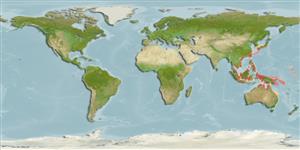Bivalvia |
Arcida |
Arcidae
Environment: milieu / climate zone / depth range / distribution range
Ecology
Benthic; depth range 0 - 20 m. Tropical
Western Pacific.
Length at first maturity / Size / Weight / Age
Maturity: Lm ?, range 2 - ? cm Max length : 11.5 cm TL male/unsexed; (Ref. 348); common length : 8.0 cm TL male/unsexed; (Ref. 348)
Shell rather thin but solid, strongly inflated, oval subquadrate in shape with rounded ventral margin, almost as high as long; slightly inequivalve, left valve overlapping the right valve on ventral and posterior margins. Cardinal area moderately large. About 34 radial ribs (32 to 36) at each valve; ribs stout and flat, larger than the interstices, smooth on both valves. Periostracum coarse and concentrically striated, easily detached, forming rows of foliations in the interstices of ribs. Internal margins with strong crenulations corresponding with the external radial ribs. No byssal gape. Colour: outside of shell white under the dark brown periostracum. Inner side bluish white.
On fine muddy-sand bottoms, in bays and coastal lagoons. Littoral and sublittoral to a depth of 20 m (Ref. 348).
Life cycle and mating behavior
Maturity | Reproduction | Spawning | Eggs | Fecundity | Larvae
Life cycle: Embryos develop into free-swimming trocophore larvae, succeeded by the bivalve veliger, resembling a miniature clam (Ref. 833).
Poutiers, J.M. 1998 Bivalves. Acephala, Lamellibranchia, Pelecypoda. p. 123-362. In Carpenter, K. E. and V. H. Niem. 1998. FAO species identification guide for fishery purposes. The living marine resources of the Western Central Pacific. Volume 1. Seaweeds, corals, bivalves, and gastropods. Rome, FAO. (Ref. 348)
IUCN Red List Status
(Ref. 130435: Version 2025-1)
CITES status (Ref. 108899)
Not Evaluated
Not Evaluated
Threat to humans
Harmless
Human uses
Fisheries: commercial
| FishSource |
Tools
More information
Trophic EcologyFood items (preys)
Diet composition
Food consumption
Predators
Population dynamicsGrowth
Max. ages / sizes
Length-weight rel.
Length-length rel.
Length-frequencies
Mass conversion
Abundance
PhysiologyOxygen consumption
Human RelatedStamps, coins, misc.
Internet sources
Estimates based on models
Preferred temperature
(Ref.
115969): 20.6 - 29.2, mean 28.6 (based on 773 cells).
Fishing Vulnerability
Low vulnerability (10 of 100).
Price category
Unknown.
